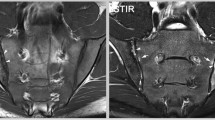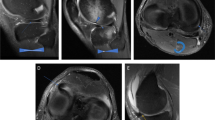Abstract
Objectives
To investigate optimised isotropic 3D turbo spin echo (TSE) and gradient echo (GRE)-based pulse sequences for visualisation of articular cartilage lesions within the knee joint.
Methods
Optimisation of experimental imaging sequences was completed using healthy volunteers (n=16) with a 3-Tesla (3T) MRI scanner. Imaging of patients with knee cartilage abnormalities (n=57) was then performed. Acquired sequences included 3D proton density-weighted (PDW) TSE (SPACE) with and without fat-suppression (FS), and T2*W GRE (TrueFISP) sequences, with acquisition times of 6:51, 6:32 and 5:35 min, respectively.
Results
One hundred sixty-one confirmed cartilage lesions were detected and categorised (Grade II n=90, Grade III n=71). The highest sensitivity and specificity for detecting cartilage lesions were obtained with TrueFISP with values of 84.7% and 92%, respectively. Cartilage SNR mean for PDW SPACE-FS was the highest at 72.2. TrueFISP attained the highest CNR means for joint fluid/cartilage (101.5) and joint fluid/ligament (156.5), and the lowest CNR for cartilage/meniscus (48.5). Significant differences were identified across the three sequences for all anatomical structures with respect to SNR and CNR findings (p-value <0.05).
Conclusion
Isotropic TrueFISP at 3T, optimised for acquisition time, accurately detects cartilage defects, although it demonstrated the lowest contrast between cartilage and meniscus.
Key points
• Cartilage is better visualised with 3D TrueFISP than 3D SPACE sequences.
• 3D TrueFISP is a reliable sequence for detecting low- and high-grade cartilage defects.
• 3D TrueFISP at 3T provides excellent contrast between cartilage and joint fluid.



Similar content being viewed by others
References
Crema MD, Nogueira-Barbosa MH, Roemer FW et al (2013) Three-dimensional turbo spin-echo magnetic resonance imaging (MRI) and semiquantitative assessment of knee osteoarthritis: comparison with two-dimensional routine MRI. Osteoarthritis Cartilage 21:428–433
Milewski MD, Smitaman E, Moukaddam H et al (2012) Comparison of 3D vs. 2D fast spin echo imaging for evaluation of articular cartilage in the knee on a 3T system scientific research. Eur J Radiol 81:1637–1643
Crema MD, Roemer FW, Marra MD et al (2011) Articular cartilage in the knee: current MR imaging techniques and applications in clinical practice and research. Radiographics 31:37–62
Hafezi-Nejad N, Guermazi A, Roemer FW et al (2016) prediction of medial tibiofemoral compartment joint space loss progression using volumetric cartilage measurments: data from the FNIH OA biomakers consortium. Eur Radiol 27:464–473
Alizai H, Roemer FW, Hayashi D, Crema MD, Felson DT, Guermazi A (2015) An update on risk factors for cartilage loss in knee osteoarthritis assessed using MRI-based semiquantitative grading methods. Eur Radiol 25:883–893
Shapiro L, Staroswiecki E, Gold G (2010) Magnetic resonance imaging of the knee: optimizing 3 Tesla imaging. Semin Roentgenol 45:238–249
Magee T, Williams D (2006) 3.0-T MRI of meniscal tears. AJR Am J Roentgenol 187:371–375
Notohamiprodjo M, Horng A, Kuschel B et al (2012) 3D-imaging of the knee with an optimized 3D-FSE-sequence and a 15-channel knee-coil. Eur J Radiol 81:3441–3449
Kijowski R, Davis KW, Blankenbaker DG, Woods MA, Del Rio AM, De Smet AA (2012) Evaluation of the menisci of the knee joint using three-dimensional isotropic resolution fast spin-echo imaging: diagnostic performance in 250 patients with surgical correlation. Skeletal Radiol 41:169–178
Jung JY, Yoon YC, Kim HR, Choe BK, Wang JH, Jung JY (2013) Knee derangements: comparison of isotropic 3D fast spin-echo, isotropic 3D balanced fast field-echo, and conventional 2D fast spin-echo MR imaging. Radiology 268:802–813
Kanal E, Barkovich AJ, Bell C (2007) ACR gudiance document for safe MR practice: 2007. AJR Am J RoentgeonI 188:1447–1474
Brennan PC, McEntee M, Evanoff M, Phillips P, O'Connor WT, Manning DJ (2007) Ambient lighting: effect of illumination on soft-copy viewing of radiographs of the wrist. AJR Am J Roentgenol 188:W177–W180
Tokuda O, Harada Y, Shiraishi G et al (2012) MRI of the anatomical structures of the knee: the proton density-weighted fast spin-echo sequence vs the proton density-weighted fast-recovery fast spin-echo sequence. Br J Radiol 85:e686–e693
Sutter R, Hodek R, Fucentesen SF, Nittka M, Pfirrmann CW (2013) Total knee arthroplasty MRI featurig slice-encoding for metal artifact correction: reduction of artifacts for STIR and proton density-weighted sequences. AJR Am J Roentgeonl 201:1315–1324
Ristow O, Steinbach L, Sabo G et al (2009) Isotropic 3D fast spin-echo imaging versus standard 2D imaging at 3.0 T of the knee--image quality and diagnostic performance. Eur Radiol 19:1263–1272
Van Dyck P, Vanhevel F, Vanhoenacker FM et al (2015) Morphological MR imaging of the articular cartilage of the knee at 3 T-comparison of standard and novel 3D sequences. Insights Imag 6:285–293
Landis JR, Koch GG (1977) The measurement of observer agreement for categorical data. Biometrics 33:159–174
Vasey MW, Thayer JF (1987) The continuing problem of false positives in repeated measures ANOVA in psychophysiology: a multivariate solution. Psychophysiology 24:479–486
Moriya S, Miki Y, Kanagaki M, Matsuno Y, Miyati T (2014) 90 degrees -flip-angle three-dimensional double-echo steady-state (3D-DESS) magnetic resonance imaging of the knee: isovoxel cartilage imaging at 3T. Eur J Radiol 83:1429–1432
Rehnitz C, Kupfer J, Streich NA et al (2014) Comparison of biochemical cartilage imaging techniques at 3 T MRI. Osteoarthr Cartilage 22:1732–1742
Duc SR, Pfirrmann CW, Koch PP, Zanetti M, Hodler J (2008) Internal knee derangement assessed with 3-minute three-dimensional isovoxel true FISP MR sequence: preliminary study. Radiology 246:526–535
Duc SR, Pfirrmann CW, Schmid MR et al (2007) Articular cartilage defects detected with 3D water-excitation true FISP: prospective comparison with sequences commonly used for knee imaging. Radiology 245:216–223
Friedrich KM, Reiter G, Kaiser B et al (2011) High-resolution cartilage imaging of the knee at 3T: basic evaluation of modern isotropic 3D MR-sequences. Eur J Radiol 78:398–405
Thorlund JB, Juhl CB, Roos EM, Lohmander LS (2015) Arthroscopic surgery for degenerative knee: systematic review and meta-analysis of benefits and harms. Br J Sports Med 49:1229–1235
Cui Y, Dyvorne H, Besa C, Cooper N, Taouli B (2015) IVIM diffusion-weighted imaging of the liver at 3.0T: comparison with 1.5T. Eur J Radiol Open 2:123–128
Chen CA, Lu W, John CT et al (2009) Multiecho IDEAL gradient-echo water-fat separation for rapid assessment of cartilage volume at 1.5 T: initial experience. Radiology 252:561–567
Jung JY, Jee WH, Park MY, Lee SY, Kim JM (2012) Meniscal tear configurations: categorization with 3D isotropic turbo spin-echo MRI compared with conventional MRI at 3 T. AJR Am J Roentgenol 198:W173–W180
Author information
Authors and Affiliations
Corresponding author
Ethics declarations
Guarantor
The scientific guarantor of this publication is Prof Louise Rainford.
Conflict of interest
The authors of this manuscript declare no relationships with any companies whose products or services may be related to the subject matter of the article.
Funding
The authors state that this work has not received any funding.
Statistics and biometry
One of the authors has significant statistical expertise and is employed as a statistician in a third level academic institution.
Informed consent
Written informed consent was obtained from all subjects (patients) in this study.
Ethical approval
Institutional Review Board approval was obtained.
Methodology
• prospective
• experimental
• performed at one institution
Rights and permissions
About this article
Cite this article
Abdulaal, O., Rainford, L., MacMahon, P. et al. 3T MRI of the knee with optimised isotropic 3D sequences: Accurate delineation of intra-articular pathology without prolonged acquisition times. Eur Radiol 27, 4563–4570 (2017). https://doi.org/10.1007/s00330-017-4816-x
Received:
Revised:
Accepted:
Published:
Issue Date:
DOI: https://doi.org/10.1007/s00330-017-4816-x




